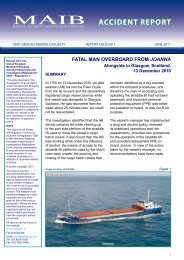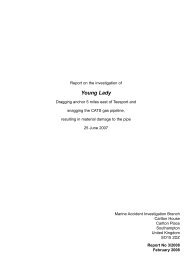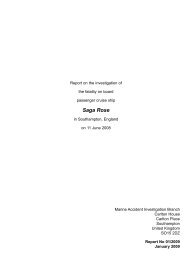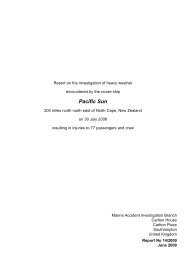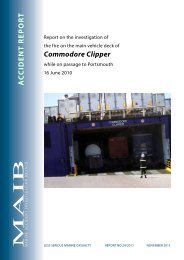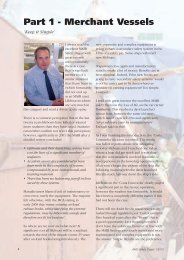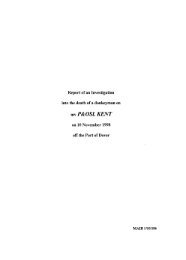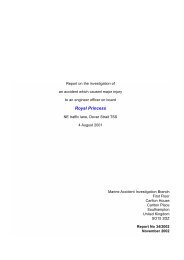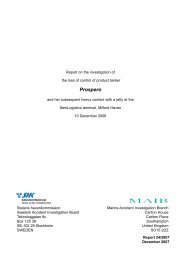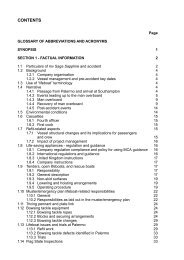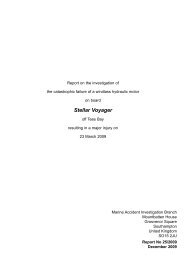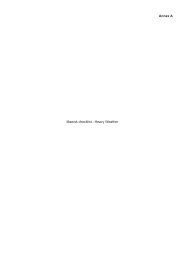Sichem Melbourne - Marine Accident Investigation Branch
Sichem Melbourne - Marine Accident Investigation Branch
Sichem Melbourne - Marine Accident Investigation Branch
You also want an ePaper? Increase the reach of your titles
YUMPU automatically turns print PDFs into web optimized ePapers that Google loves.
SECTION 2<br />
2.1<br />
2.2<br />
2.3<br />
AIM<br />
- ANALYSIS<br />
The purpose of the analysis is to determine the contributory causes and circumstances<br />
of the accident as a basis for making recommendations to prevent similar accidents<br />
occurring in the future.<br />
CAUSE OF ThE ACCIDENT<br />
The accident was primarily caused by a failure to exchange an appropriate level of<br />
information between the master and pilot before departure from the berth. Assumptions<br />
were made by both parties of the other’s intentions. As the accident started to unfold,<br />
communications between the pilot and the master still did not improve, with each<br />
attempting different remedial manoeuvres, serving only to compound the problem.<br />
The pilot felt there was no need to explain in full, to an experienced master, his<br />
procedures for what he regarded as a basic ship manoeuvre. The master, on the other<br />
hand, felt that if there was a possibility of needing to come off the berth astern, then a<br />
tug would have been employed.<br />
PILOTAGE<br />
Compulsory pilotage was required for <strong>Sichem</strong> <strong>Melbourne</strong> as, under the PLA Pilotage<br />
Directions, she was regarded as a specified vessel (vessels carrying “flammable liquids<br />
and substances in bulk or being non-gas free following discharge of these cargoes”). A<br />
class 1 pilot of many years experience was deployed for the task of conducting <strong>Sichem</strong><br />
<strong>Melbourne</strong>’s navigation from the berth to anchorage. The manoeuvre planned by the<br />
pilot was one he had carried out many times before and was the accepted method<br />
carried out by many PLA pilots in similar circumstances.<br />
Experienced pilots are regarded as a major control measure in PLA’s risk assessments.<br />
Once trained and authorised, pilots attend the Authority’s in house ship’s bridge<br />
simulator for ship handling experience every 2 years, and the pilot in question had<br />
attended simulator training on two occasions. The simulator is used to provide<br />
training in ship handling techniques only, and does not cover bridge team interaction<br />
or relationships with masters. Following simulation, pilots’ performances are peer<br />
reviewed as part of the training procedures. The Authority had no means in place<br />
for monitoring pilots’ performance of such items as the quality of master and pilot<br />
exchanges or pilots’ bridge team interaction on board vessels, despite pilot monitoring<br />
being recommended within the PMSC.<br />
Tugs are normally ordered by the master or his designated agent ashore. Should a<br />
pilot feel a tug is required for a given situation he can advise the master of this and<br />
expect full co-operation. In an emergency, however, the pilot can request a tug through<br />
the duty port controller. After <strong>Sichem</strong> <strong>Melbourne</strong>’s engine was re-started, following<br />
shutdown, the pilot cancelled the emergency tug without the full knowledge of the cause<br />
of engine failure; this might have been somewhat premature given that there was no<br />
guarantee that further failures would not occur until the engine and controls had been<br />
checked out. The duty port controller was made aware of the tug cancellation some 15<br />
minutes after it had happened.<br />
19



